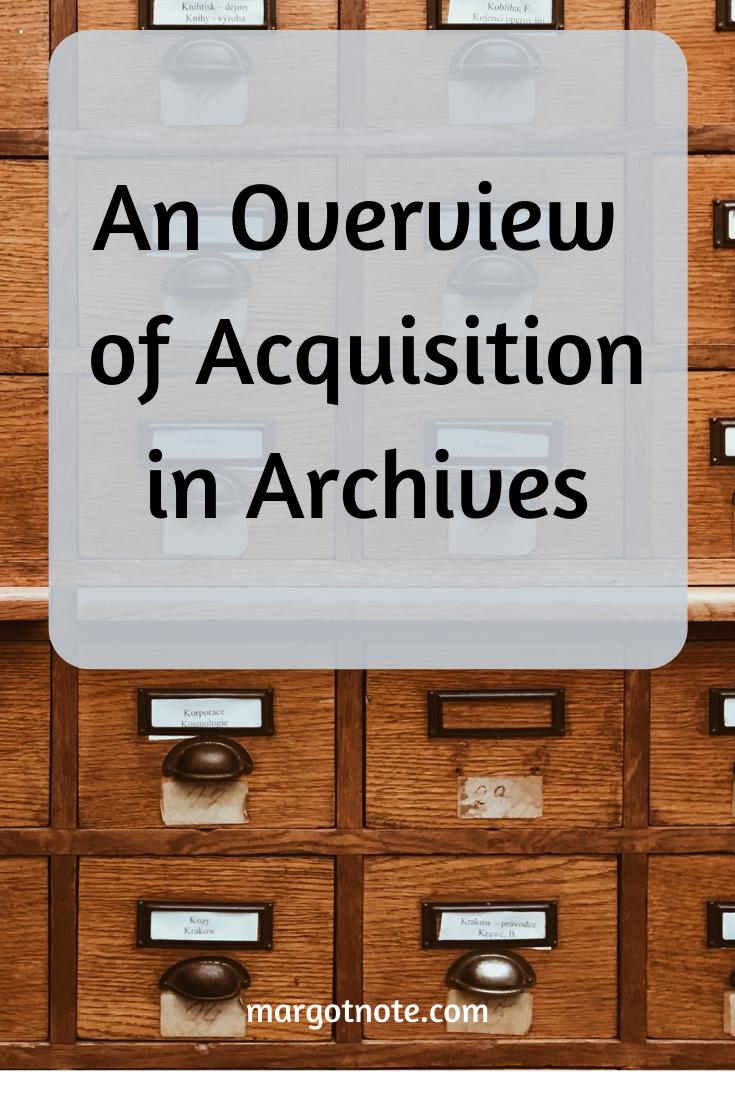Acquisition is the process of acquiring records by transfer, donation, or purchase. It begins with a lead file, a way to keep track of donor contacts.
Relationships develop over time, and archivists should track any correspondence with potential donors. Background information is important too. Is the collection already in another repository or part of another collection? Is the donor talking to other repositories? Initial contact by an archivist or via a contact close to the potential donor should be treated carefully. The archivist must convince the donor of the sincerity of the repository and why their collection would be a good fit for the institution and its mission.
The examination of archival material is best done in person, although that may difficult with distant collections. Not only should archivists understand what is in the collection, but where materials are stored can be illuminating. For example, if materials are in the office, they are more likely to be of current use to the records creator than if they were in the basement. The arrangement of the office may provide clues to the collection’s provenance and original order as well. Types of storage areas also alert archivists to potential conservation problems.
The Deed of Gift
A negotiation of terms follows, which should result in an explicit agreement that covers the physical transfer, the rights of ownership, access terms, and a clarification of copyright. The legal and physical transfer of a collection to a repository should be documented, and that documentation can occur via letter, will, or most commonly, a deed of gift. In any case, the document should contain the following information:
Name of the donor, which is sometimes complicated if a person is signing on behalf of an organization.
Name of the recipient, who in the organization can legally accept materials.
Date of transfer, which might include more than one date, or later materials may be given under the terms of the earlier deed.
Description of material to distinguish among donations.
Copyright, which the donor can only transfer if they have it. For example, a donor might have physical ownership of the letters received, but the writer of the letters retains copyright.
Restrictions, which outlines who can impose them, who can lift them, and to whom do restrictions apply.
Disposal authority because the archives may want to discard items from a collection. Does the donor agree, or do they want everything returned?
Additions, if subsequent gifts are possible.
Physical Transfer
The physical transfer is also best done in person for several reasons. The archivist can note where materials were stored before packing and can be clear as to what is next to what in the containers and the number the containers. Archivists can also get a lot of information from the donor during this process, information that is likely to be useful later during arrangement and description.
Archivists also follow-up after the transfer. Acknowledgment of the collection is essential, as is following through on other donor wishes or resolving any disputes of the agreement.
Some Bumps on the Road
The acquisition process is not always straightforward. For example, archivists need to make sure that the person has the right to donate the material, which is not always the case and sometimes unclear.
Monetary appraisal may be an issue. When donors ask for an appraisal for tax purposes, archivists must refer donors to qualified appraisers and cannot be a party to the transaction.
Handling Restrictions
There is also the matter of restrictions. Materials can be confidential by law or can contain information that necessitates closure or limited access. Archivists should determine this at the time of transfer, and any restrictions should be articulated in the gift agreement.
While archivists try to make as much material open as soon as possible, they also recognize privacy issues. Sometimes the donor brings them up; sometimes, the archivist uncovers such material during an examination of the collection. Restrictions do not have to apply to the entire collection; they can apply only to relevant series or files. Restrictions should be clear and equally applied to all users and have an endpoint. Restrictions can result in files being closed or require the permission of the archivist. Restrictions can also indicate that individual names cannot be used in cases where aggregate data is permissible, but not the release of personally identifiable information.
Procuring Comprehensive Holdings
Acquisition allows the archival institution to make decisions and allocate resources. It permits the repository to procure comprehensive holdings in a planned, coordinated, and systematic manner. The process is a basis for acquisition strategies and helps plan for the efficient identification and preservation of archival materials.
The blog was originally published on Lucidea's blog.































